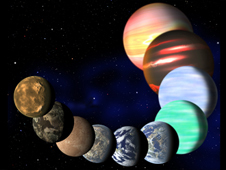Researchers: Habitable zone is probably narrower than hoped
 types of planets Kepler found/NAA
types of planets Kepler found/NAA Various researchers have claimed that there could be 40 billion to 100 billion habitable planets in the Milky Way but recent research throws cold water on that:
These results are certainly encouraging, since they suggest that the Milky Way could be teeming with life. Unfortunately, more recent research into extra-solar planets has cast doubt on these previous estimates. This is especially the case where tidally-locked planets that orbit M-type (red dwarf) stars are concerned.
In addition, research into how life evolved on Earth has shown that water alone does not guarantee life – nor, for that matter, does the presence of oxygen gas. Further to this, Schwieterman and his colleagues considered two other major biosignatures that are essential to life as we know it – carbon dioxide and carbon monoxide. Matt Williams, “Complex Life Might Require a Very Narrow Habitable Zone” at Universe Today
He goes on to raise many additional issues as well.
Follow UD News at Twitter!
See also: Astrophysicist: Alien Hunters, Please Stop Using The Drake Equation
Copyright © 2019 Uncommon Descent . This Feed is for personal non-commercial use only. If you are not reading this material in your news aggregator, the site you are looking at is guilty of copyright infringement UNLESS EXPLICIT PERMISSION OTHERWISE HAS BEEN GIVEN. Please contact legal@uncommondescent.com so we can take legal action immediately.
Plugin by Taragana
Michael J. Behe's Blog
- Michael J. Behe's profile
- 219 followers



